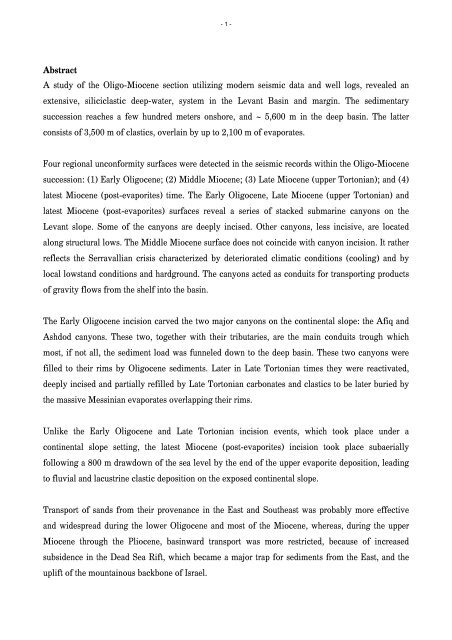The Oligo-Miocene deepwater system of the Levant Basin
The Oligo-Miocene deepwater system of the Levant Basin
The Oligo-Miocene deepwater system of the Levant Basin
You also want an ePaper? Increase the reach of your titles
YUMPU automatically turns print PDFs into web optimized ePapers that Google loves.
- 1 -AbstractA study <strong>of</strong> <strong>the</strong> <strong>Oligo</strong>-<strong>Miocene</strong> section utilizing modern seismic data and well logs, revealed anextensive, siliciclastic deep-water, <strong>system</strong> in <strong>the</strong> <strong>Levant</strong> <strong>Basin</strong> and margin. <strong>The</strong> sedimentarysuccession reaches a few hundred meters onshore, and ~ 5,600 m in <strong>the</strong> deep basin. <strong>The</strong> latterconsists <strong>of</strong> 3,500 m <strong>of</strong> clastics, overlain by up to 2,100 m <strong>of</strong> evaporates.Four regional unconformity surfaces were detected in <strong>the</strong> seismic records within <strong>the</strong> <strong>Oligo</strong>-<strong>Miocene</strong>succession: (1) Early <strong>Oligo</strong>cene; (2) Middle <strong>Miocene</strong>; (3) Late <strong>Miocene</strong> (upper Tortonian); and (4)latest <strong>Miocene</strong> (post-evaporites) time. <strong>The</strong> Early <strong>Oligo</strong>cene, Late <strong>Miocene</strong> (upper Tortonian) andlatest <strong>Miocene</strong> (post-evaporites) surfaces reveal a series <strong>of</strong> stacked submarine canyons on <strong>the</strong><strong>Levant</strong> slope. Some <strong>of</strong> <strong>the</strong> canyons are deeply incised. O<strong>the</strong>r canyons, less incisive, are locatedalong structural lows. <strong>The</strong> Middle <strong>Miocene</strong> surface does not coincide with canyon incision. It ra<strong>the</strong>rreflects <strong>the</strong> Serravallian crisis characterized by deteriorated climatic conditions (cooling) and bylocal lowstand conditions and hardground. <strong>The</strong> canyons acted as conduits for transporting products<strong>of</strong> gravity flows from <strong>the</strong> shelf into <strong>the</strong> basin.<strong>The</strong> Early <strong>Oligo</strong>cene incision carved <strong>the</strong> two major canyons on <strong>the</strong> continental slope: <strong>the</strong> Afiq andAshdod canyons. <strong>The</strong>se two, toge<strong>the</strong>r with <strong>the</strong>ir tributaries, are <strong>the</strong> main conduits trough whichmost, if not all, <strong>the</strong> sediment load was funneled down to <strong>the</strong> deep basin. <strong>The</strong>se two canyons werefilled to <strong>the</strong>ir rims by <strong>Oligo</strong>cene sediments. Later in Late Tortonian times <strong>the</strong>y were reactivated,deeply incised and partially refilled by Late Tortonian carbonates and clastics to be later buried by<strong>the</strong> massive Messinian evaporates overlapping <strong>the</strong>ir rims.Unlike <strong>the</strong> Early <strong>Oligo</strong>cene and Late Tortonian incision events, which took place under acontinental slope setting, <strong>the</strong> latest <strong>Miocene</strong> (post-evaporites) incision took place subaeriallyfollowing a 800 m drawdown <strong>of</strong> <strong>the</strong> sea level by <strong>the</strong> end <strong>of</strong> <strong>the</strong> upper evaporite deposition, leadingto fluvial and lacustrine clastic deposition on <strong>the</strong> exposed continental slope.Transport <strong>of</strong> sands from <strong>the</strong>ir provenance in <strong>the</strong> East and Sou<strong>the</strong>ast was probably more effectiveand widespread during <strong>the</strong> lower <strong>Oligo</strong>cene and most <strong>of</strong> <strong>the</strong> <strong>Miocene</strong>, whereas, during <strong>the</strong> upper<strong>Miocene</strong> through <strong>the</strong> Pliocene, basinward transport was more restricted, because <strong>of</strong> increasedsubsidence in <strong>the</strong> Dead Sea Rift, which became a major trap for sediments from <strong>the</strong> East, and <strong>the</strong>uplift <strong>of</strong> <strong>the</strong> mountainous backbone <strong>of</strong> Israel.
















